Alto Sax - Reeds, Cleaning and More
Share
Is there any way to avoid teeth marks on the mouthpiece?
The mouthpiece is a consumable item, and it naturally accumulates teeth marks, but a mouthpiece patch is one method of preventing this. However, when the teeth are making strong contact (i.e. there is a tendency to bite down), there may be a problem with the embouchure. With proper embouchure, the teeth are just touching the mouthpiece, and the muscles around the mouth are closing on the mouthpiece.
Getting the Reed on Correctly
The tip of the reed is typically lined up flush with the tip of the mouthpiece, but in some cases, depending on the player, there may be very slight variations (of up to around 0.3 mm). There can also quite a bit of difference from player to player when it comes to the position of the ligature, but it is usual to attach and tighten it down below the point of the reed where the slope stops.
When a reed is held up to the light, light passes through the thinner, transparent part, making it brighter, and the thicker parts that light does not pass through look darker. There are those who say that for good reeds, this thicker, dark part of the reed, the heart, should look something like a symmetrical mountain.
Don't drop the mouthpiece!
The mouthpiece is a critical component of the saxophone. The tip is especially thin and vulnerable to cracks and chips, so it's important to be very careful not to drop it. Any cracks, chips, splitting, or other damage to this delicate part of the instrument can have an impact on the quality of sound.
Lots of sharps in the score
Tenor and soprano saxophones are in the key of B♭, just like clarinets. All three of these instruments produce a B♭ when playing a C on the score. That is why in order to produce the same C pitch as keyed instruments or the flute (concert or "written" C), they must actually play a D. Because the D major key is a whole step above the C major key, it contains two sharps.
Since alto and baritone saxophones are in E♭, (meaning they produce an E♭ when playing a written C), in order to produce an actual C, they must play an A, which is a perfect third down from C. In this case the key becomes A major, meaning that there are three sharps.
Sheet music for wind instruments are nearly always only parts of the score, so it is arranged for the key of the instrument it is written for.
CLEANING - AS WITH any wind instrument,
It is important to remove dirt and moisture!
DAILY -
1. First take care of the mouthpiece and neck
Remove the reed and use a cleaning swab (S) to remove dirt from the mouthpiece. Be careful not to damage the tip of the mouthpiece when cleaning. Next, remove the moisture from the inside of the neck using a cleaning swab (S).
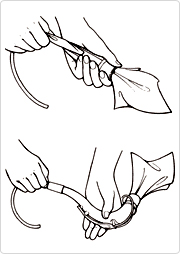
2. Completely remove the moisture from the pads
If the pads are damp, use a cleaning paper to remove the moisture completely from the pad and the tone hole opening.
The keys need to be removed in order to clean the tone holes. We do not recommend disassembling your instrument on your own. Instead, take it in to a music shop for maintenance.

Cleaning paper
Put a piece of cleaning paper between the pad and the tone hole and lightly press the key several times. Change the position of the paper and repeat this process two or three times.
*Do not pull the paper out while depressing the key.
*If the pad is sticky, use powder paper.
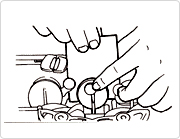
3. Clean the inside of the tube with a cleaning swab.
Insert a saxophone cleaning swab into the bell and pull it through the neck joint to clean.
4. Remove dirt from the surface with a polishing cloth.
Use a polishing cloth to remove finger prints and dirt from the surface of the instrument.
5. Carefully clean the octave key
The tone hole of the octave key is small and easily clogged, so clean it with a tone hole cleaner. Be careful not to damage the tone hole with the metal tip of the tone hole cleaner.
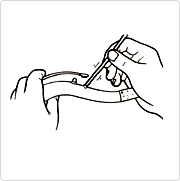
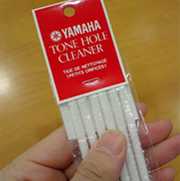
There is also weekly and periodic cleaning routines you can find here: https://www.yamaha.com/en/musical_instrument_guide/saxophone/maintenance/maintenance003.html
Attach the reed to the mouthpiece
Place the reed on the mouthpiece with the flat side touching the mouthpiece, then tighten the ligature to hold it in place.
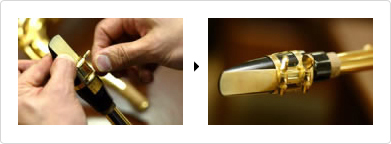
Attaching the reed to the black mouthpiece. Reeds come in different sizes from 1, 1-1/2, 2, 2-1/2, 3, 3-1/2, 4, 4-1/2 to 5.
The mouthpiece, reed, and ligature form the sound generating portion of the instrument, and so they have a large influence on the quality of the instrument's sound. They will also affect the feel of playing the instrument.
Reeds don't last long
The closer a part of the instrument is to the mouth of a player, the stronger its impact on the sound. This is why the reed is one of the most critical parts. Expect a reed to last for around a week to two weeks. When you change from a reed you've been using for some time to a new reed, the sound of your instrument will change with it.
